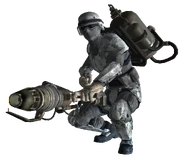The Sino-American War was a conflict between the United States and China beginning in 2066 as part of the Resource Wars and culminated with the Great War in 2077.
Engagements
- Battle of Anchorage, part of the Chinese invasion of Alaska.
- Niagara Sabotage.
- Yangtze Campaign, part of the American invasion of mainland China (Nanjing and Shanghai).
- Gobi Campaign, part of the American invasion of mainland China and Mongolia.
- Great War.
Prelude
In the Spring of 2066, with global oil resources diminishing and China's fossil fuel dependency causing an energy crisis in the nation, China became more aggressive in its trade talks with the United States. With the United States unwilling to export oil to China, Chinese-American relations turned for the worse.
Timeline
- Winter 2066 - China invades Alaska, marking the beginning of the Sino-American War. The Anchorage Front Line becomes the main battle front during the Anchorage Campaign.
- 2066 - The American missile cruiser USS Ebon Atoll is sunk near the Alaskan coast by the American submarine USS Interference, which mistook it for a Chinese warship.
- 2067 - The first suits of T-45d power armor are deployed in Alaska.
- 2073 - China aggressively increases their use of biological weapons, causing the United States to form the Pan-Immunity Virion Project.
- 2074 - The United States deploys power armor units, infantry, and mechanized divisions to the Chinese mainland and annexed countries, but become bogged down on the mainland, causing further strain on American resources.
- June 2076 - The new and improved T-51b power armor are deployed to the Chinese mainland where it begins to cut a path of destruction through the Chinese forces. Chinese resources are strained to the breaking point and Chinese-annexed countries begin to break down.
- 2077 - A Chinese sabotage attempt takes place at Hoover Dam.[1]
- January 10, 2077- Alaska is liberated, and reclaimed by the United States.
- October 23, 2077- The Great War begins, a massive nuclear exchange between the nuclear powerhouses of the world. It lasts only two hours, but releases more energy than all the wars in world history. Both China and the United States are left severely destroyed and inoperable beyond Old World standards.
Aftermath
During and after the war the North American and East Asian continents suffered greatly. The most significant political consequences of the war in the United States were the Canadian annexation, the Canadian resistance and protests, and riots prompted by food shortages which resulted in the declaration of martial law. The conflict culminated in a nuclear exchange that would become known as the Great War. In a sense, the Sino-American war ended in stalemate as both sides were deprived of resources, suffered enormous military and civilian casualties and were ultimately decimated by total nuclear war.












